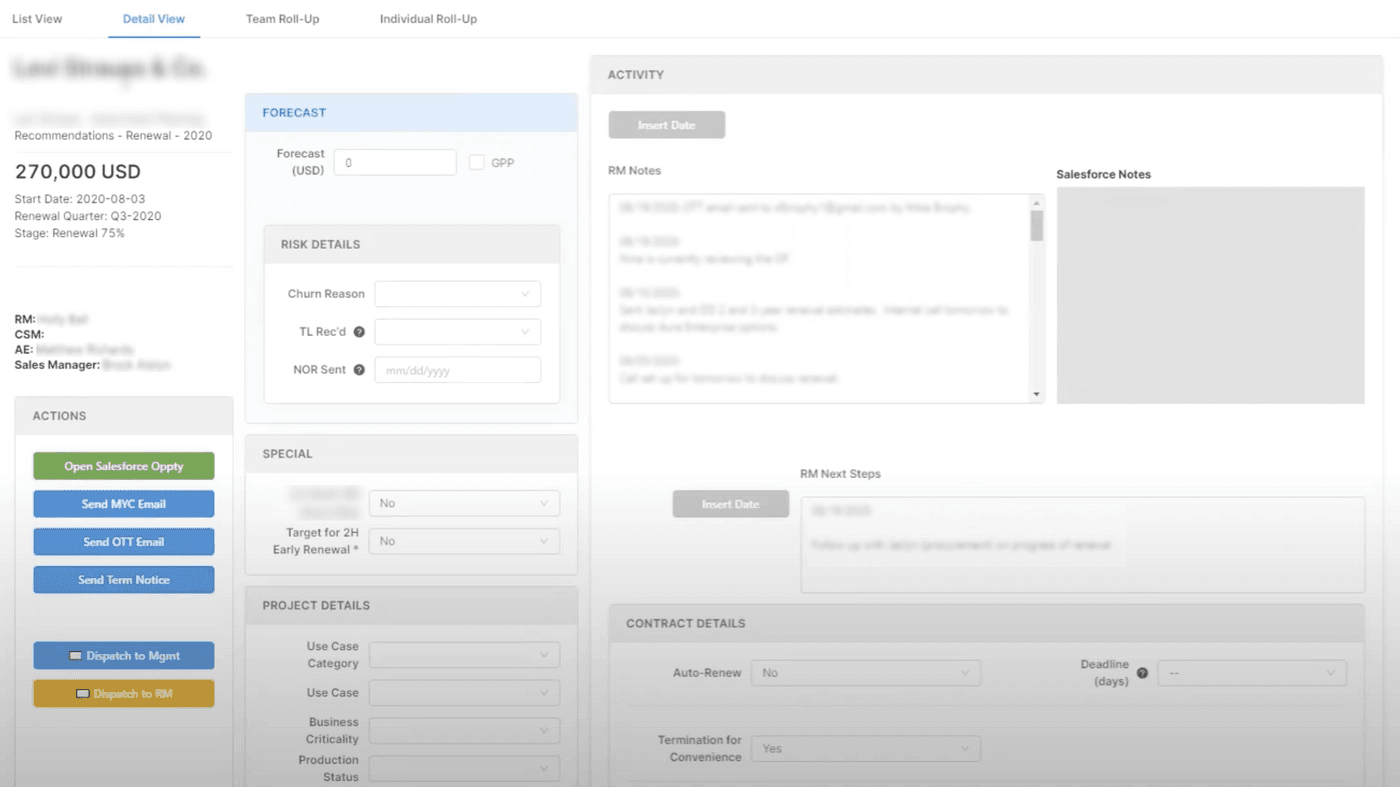As a company grows, the roles and functions within it grow and change, too. A marketing team might go from one Jane of all Trades to a team of 30 spanning content, paid acquisition, organic social, and events. And as companies grow, their needs for software inevitably change, too: after all, you can’t track your OKRs on post-its forever.
A team that’s often first to grow as a company takes off is sales. As sales increase and your customer base expands, what once was just ‘the sales team’ might become different, standalone functions within the organization such as new business, renewals, and ongoing customer support.
Neo4j, a startup specializing in SaaS graph databases, was founded in 2010 and is no stranger to growth and change. So when it reached an inflection point in its trajectory, and its sales org started to shift accordingly, nobody was better suited for the job of managing its new sales renewals team than Mike Brophy. He joined the team in 2019 as their VP of Global Renewals Sales. His job is to scale the team that manages the ever-growing chunk of revenue that comes from the company’s contract renewals.
Once on the team, Mike realized that not only had Neo4j outgrown its organization’s team structure—hence the new renewals team he was there to lead—but it had also outgrown the tooling it was using for renewals.
For many years, the sales team managed the renewals process using Google Sheets. So with a reorganization underway and customer success taking over renewals, it only felt natural for them to keep using Google Sheets. But once the team was hired and ramping up renewals, Mike realized Google Sheets just wouldn’t cut it.
Moving the team to Salesforce as their primary tool was considered, but as the name suggests, it was set up for Neo4j’s sales team: they could accomplish all of their goals with the software, but the renewals team, on the other hand, had different goals, tasks, and forecasting methodology. Any Salesforce-based approach would be too time-consuming and expensive, requiring the work of a sales ops engineer or Salesforce specialist.
The renewals team is different from the sales team in many ways: different goals, tasks to complete, forecasting motion, and timelines. “Our renewals initiatives and campaigns can change every quarter and require special data to be surfaced to the reps,” Mike explains, “By the time a sales ops developer could make changes in Salesforce given their many other priorities, it was too late.”
Mike needed a new solution for his team that would allow them to forecast revenue and generate reports with custom data, get a bird’s-eye view of all accounts, see emerging trends, and customize reporting and data collection without involving engineers.
“All I wanted was easily customized software that would keep us on track toward quarterly renewals initiatives, allow us to build and configure custom solutions, and didn’t cost too much.”
After all, the data was available, but it didn’t have a frontend that could be configured by the team, so they weren’t able to see it most of the time. Configuring the frontend would involve a sales operations specialist to update Salesforce—a resource Mike’s team didn’t have.
What’s more, Mike saw the toll that bouncing between applications took on his team: “Moving from app to app requires constant context switching, which equals lost time and productivity—I wanted to empower my team to stay focused on successfully working and forecasting renewals all within one tool,” he says.
Luckily for Mike and his team, he used to be a solutions architect, so he knew a thing or two about building out complex technical systems—in fact, he fondly calls himself a “developer at heart.”
Thanks to his experience, Mike has developed a hard-and-fast rule for trying new software: “No tool is worth using if it takes me longer than a weekend to form a proof-of-concept for my use cases,” he explains.
In his search for a solution that would empower his team with data and customization, Mike looked at several apps, all of which were either too expensive or complex—they all failed his proof-of-concept test.
“When I found Retool, I was blown away: In one weekend, I formed the proof-of-concept for a renewals app and was sold.”
So the Neo4j Renewals Control Center (RCC) was born and became a vital part of the organization’s workflows—and ability to accurately forecast and hit renewal targets.

The renewals team manages 200 renewals every quarter. Each renewal represents a contract (or several) and shifting revenue potential, so it can be challenging to know what actions are required of Mike and his team. “Managing hundreds renewals at once is similar to tracking hundreds stocks every day,” he says. “How do you figure out where you need to focus your attention?” Accounts vary in the amount of attention they need, follow up actions, and fluctuations in revenue they represent.
Using Salesforce, Mike would ask his reps for account updates during their regular meetings. He had no way to see renewal timelines in one place or track down statuses without involving his team, which felt like he was chasing information or interrupting his reps’ days just to get a pulse on their accounts.
With the RCC, Mike can easily track the stage of each renewal contract and even filter by rep. He now has a clear understanding of the work his team is doing and knows where to deploy his reps to make sure renewals are completed without a hitch.
The reality is, forecasting is important—but it’s also hard to do well. And for Mike, it’s crucial to track his team’s expected revenue closely to know whether they will meet their quarterly goals or not.
In Salesforce, the task of forecasting renewals was virtually impossible: Mike had to rely on reps reporting individual changes in renewal forecasts on their own. This made him feel powerless as a manager—and it took time for reps to input information, meaning his forecasting models were never quite up to date.
Now, using Retool and the RCC, a Zapier integration creates an automated email notification anytime the forecast for an account changes. Instead of hunting down changes, Mike now receives an email with the account name, renewal manager, forecast change, and next steps anytime a rep updates the expected revenue on an account.
With the added visibility of up to date forecasts and automated notifications, Mike can proactively reach out to his reps and help them get forecasted revenue back on track if it’s falling behind. “I love the ability Retool gives me to stay on top of all of our contracts and identify which need extra attention without having to manually chase it down,” he says.
Before the RCC, adding metadata or custom fields to an account in Salesforce required a sales ops engineer and took weeks or months to implement—time Mike and his team just didn’t have. “Customer details are crucial for contract negotiation, which is the main responsibility of a renewal rep,” Mike explains. “Even the smallest tidbits of extra information can help my team go the extra mile to win a deal or make a customer feel more cared for.”

Now, the RCC gives every rep a broad overview of their accounts, complete with extra details that were often left out of Salesforce profiles. These might include the reason for churn, contract details, or personal notes about a contact.
Not only can they capture custom data in the RCC, but when the company or team targets shift, the team has the agility to make immediate changes to the UI and start collecting relevant data right away.
“I can go into Retool in a matter of half an hour, add a field, wire it up, and start collecting the data right away,” Mike said. “Plus, it’s the same UI our reps use every single day for all their other opportunities.” This added bonus is huge for Mike and his team: because they’re using the same tool with a familiar UI, everyone’s daily workflows on without any disruptions (yet with all the data they need).
“My team spends 95% of their time in Retool—it’s where the information is and where they can trust the data is up to date and complete,” Mike explains. By streamlining where the relevant data is stored, Mike helps his team be more efficient. Retool keeps them from bouncing around from tool to tool, application to application, and focused on the information and priorities at hand.
Not only does Retool help his team, it also allows Mike to check in on how they’re doing and drive check-ins with his reps. It allows him to gather data and pull together reports before team calls and one-on-ones with a few clicks. “I love that Retool makes my team more efficient and it helps me better manage them, too,” he says.
While Salesforce works for many teams, it just didn’t for Mike’s. Without the ability to view, analyze, collect, and customize the data they needed, it would have been much more difficult for the team to deliver and meet their targets. With Retool, Mike can easily build customized tools with barely any code.
"Within a month, the RCC was working the way I wanted," he says. "I wouldn't have gotten this done in a year otherwise. And it certainly wouldn't have met all of my functional requirements, let alone been customizable by me and my team."
The RCC is already paying dividends after being in production for six months. Churn due to late renewals has improved many-fold, and last-minute forecast surprises (the enemy of renewals) have been nearly eliminated. The way Mike sees it, Retool is his team's special sauce. "I've got my secret weapon," he says. "I've got Retool."
Reader



